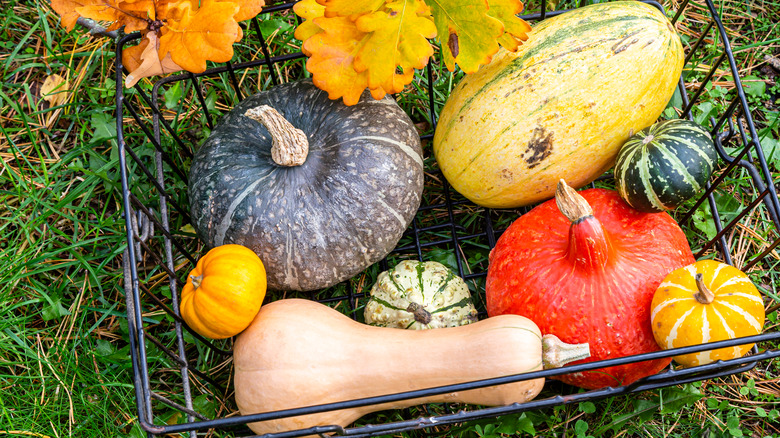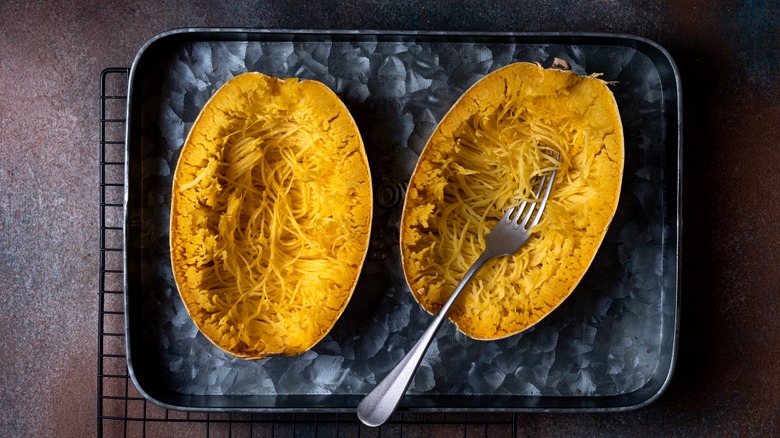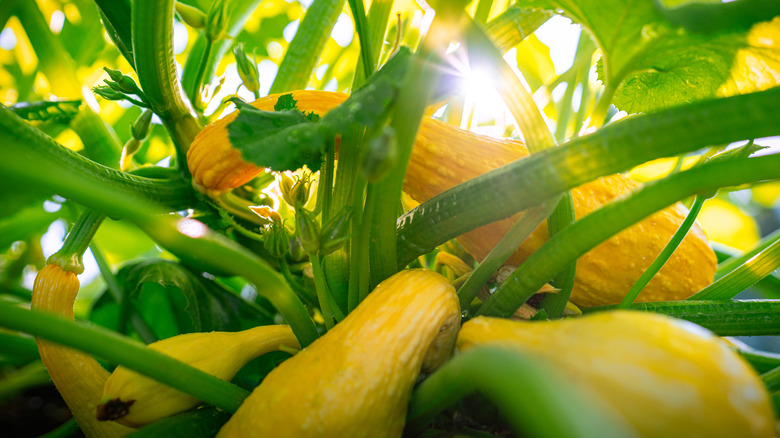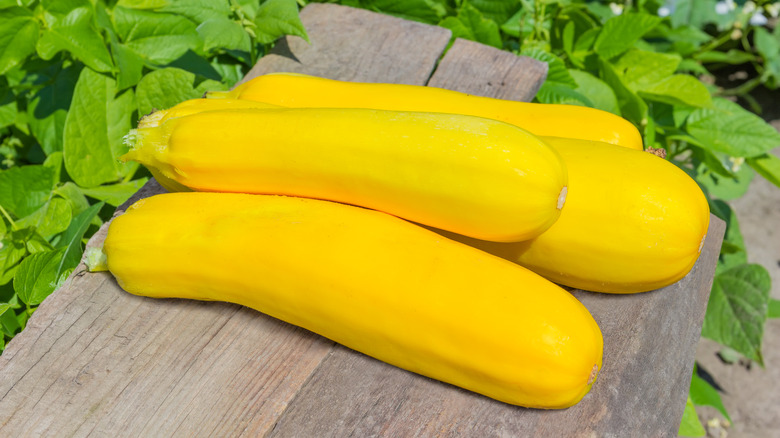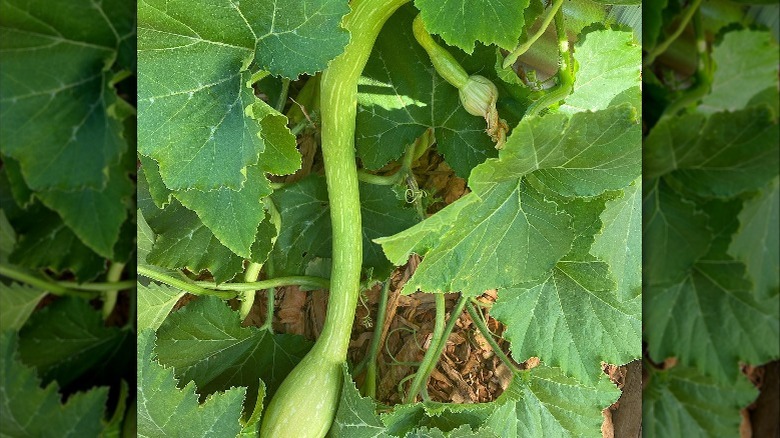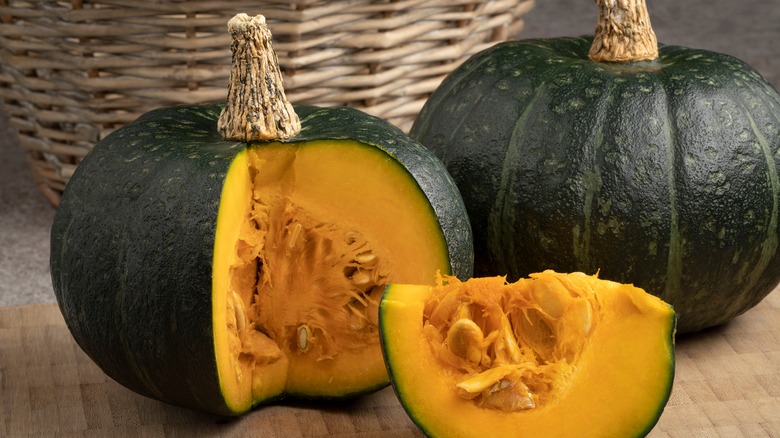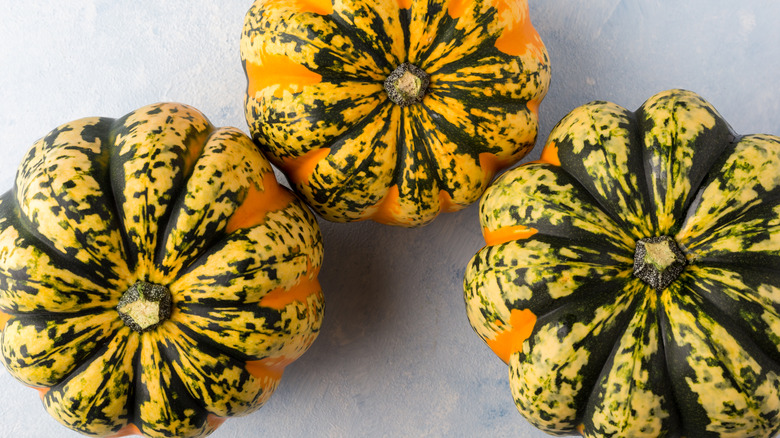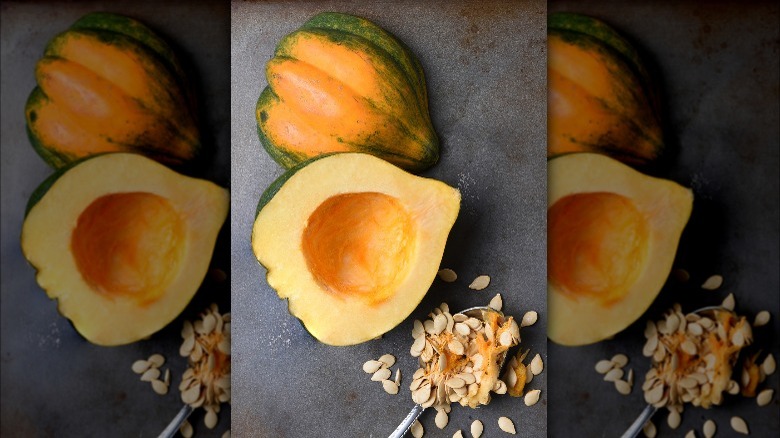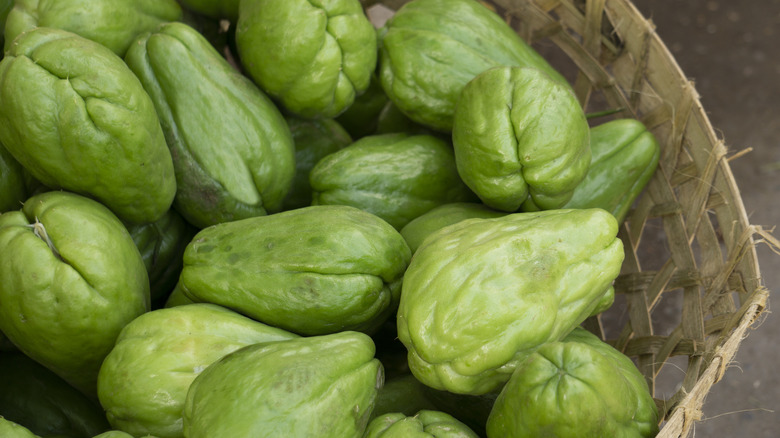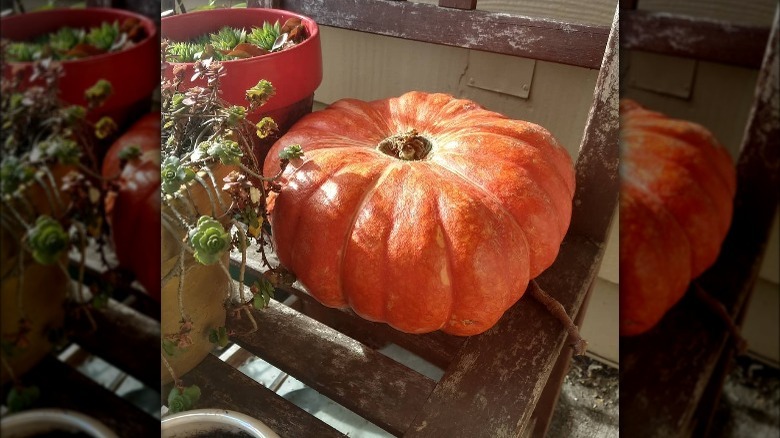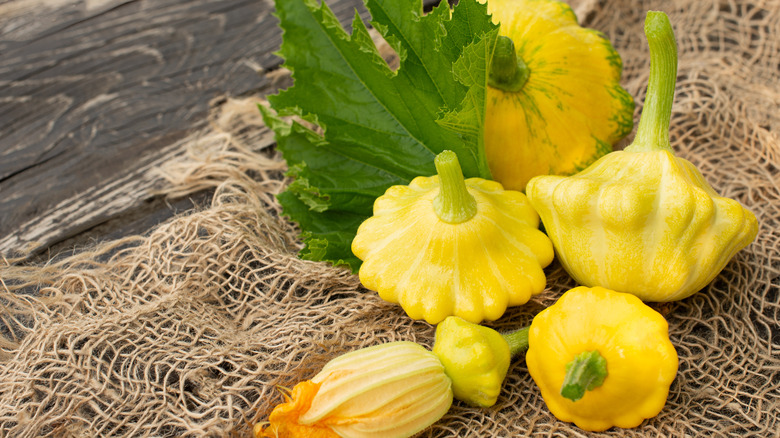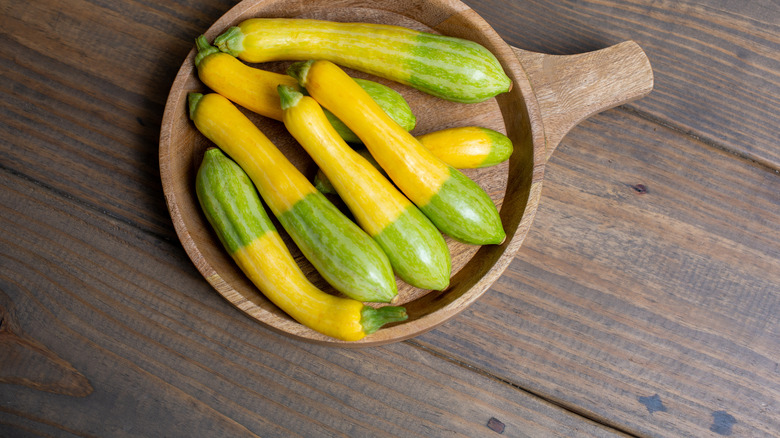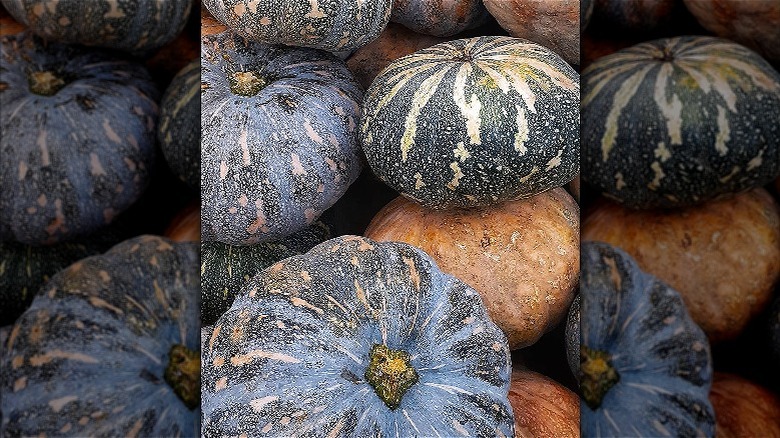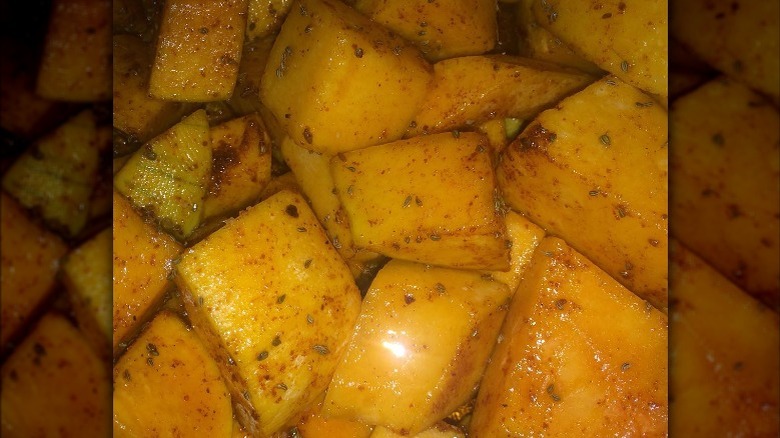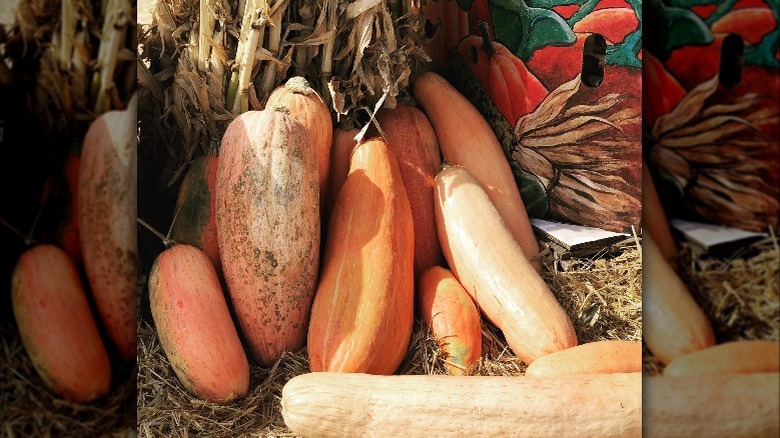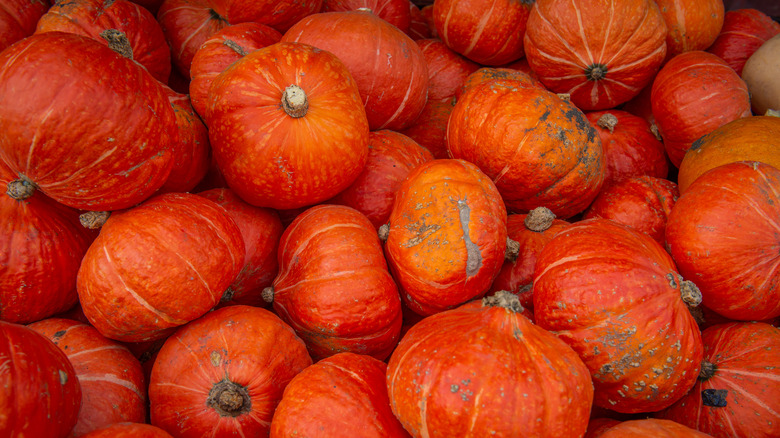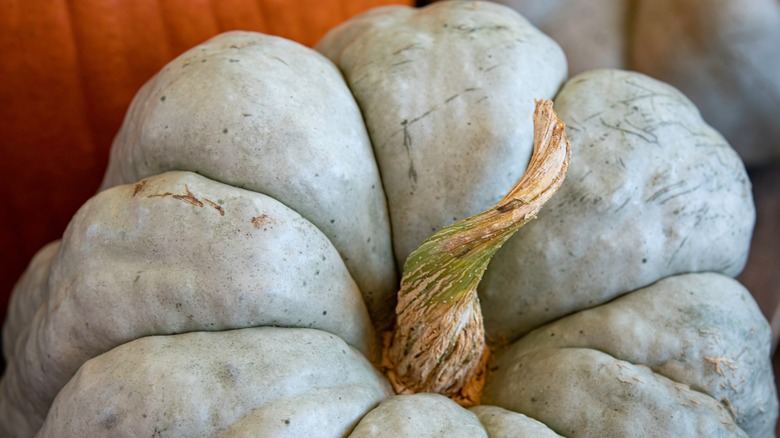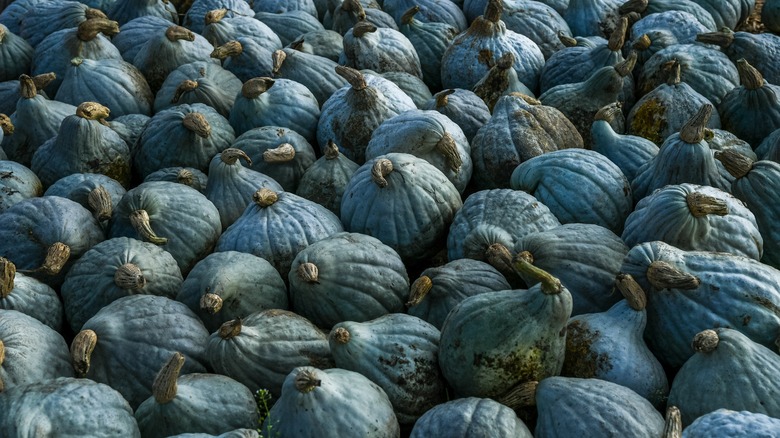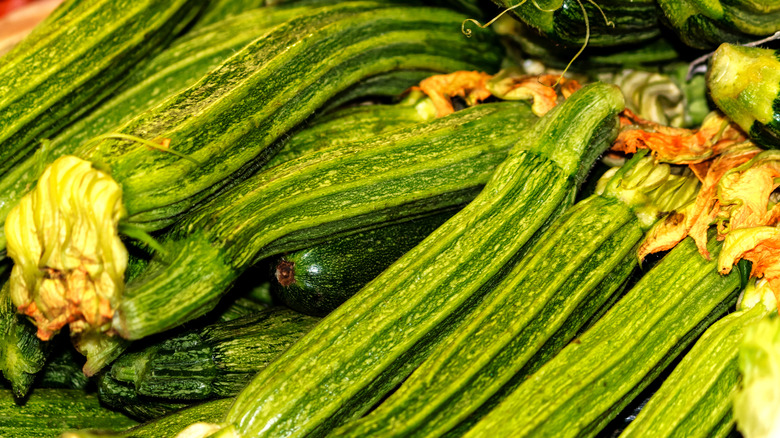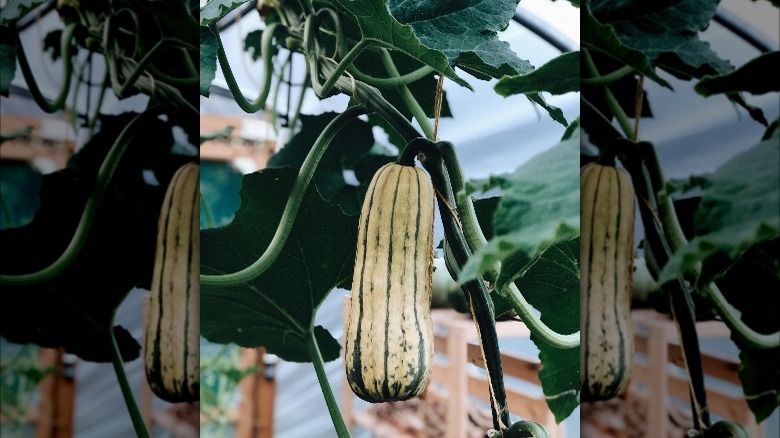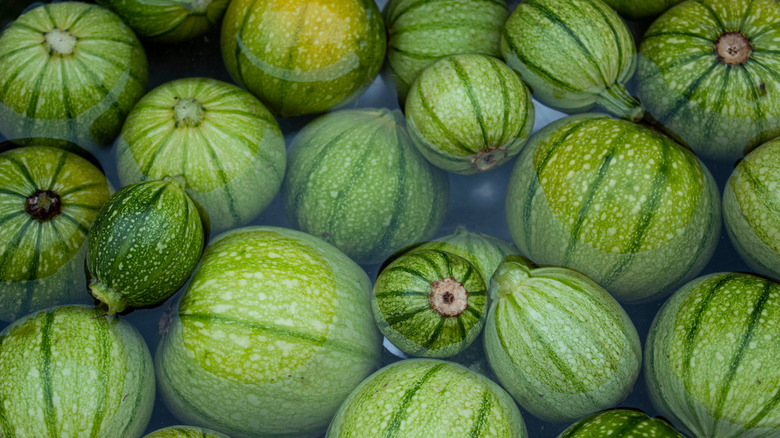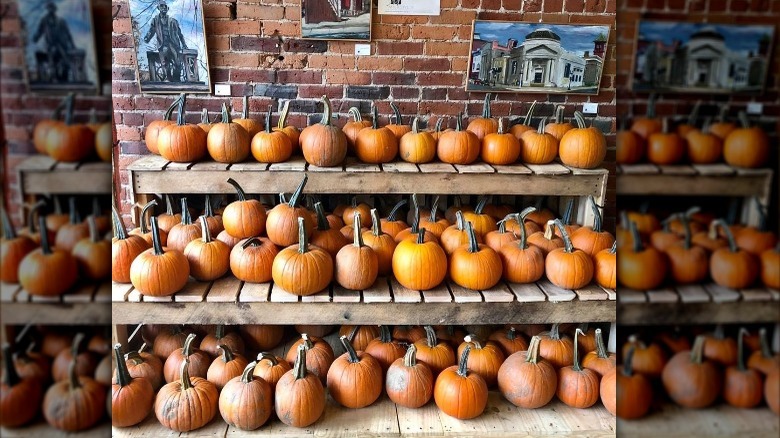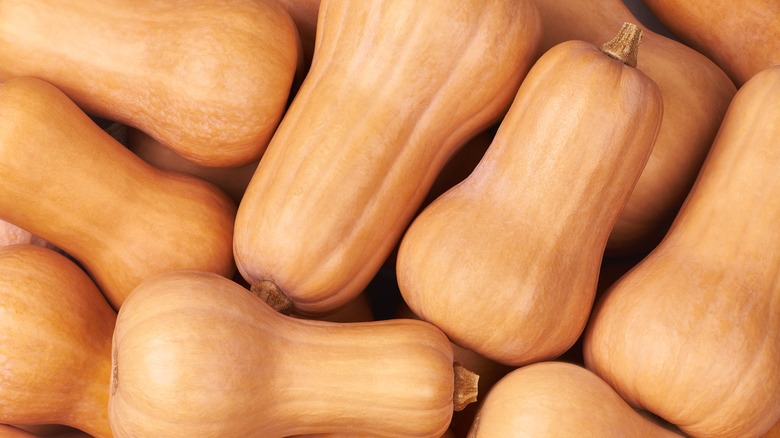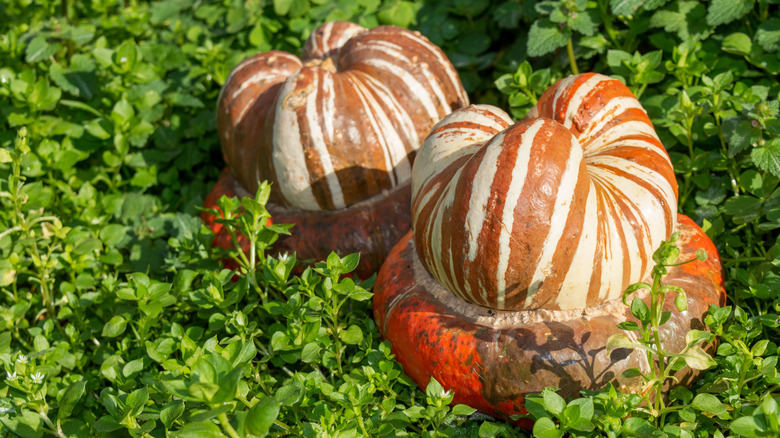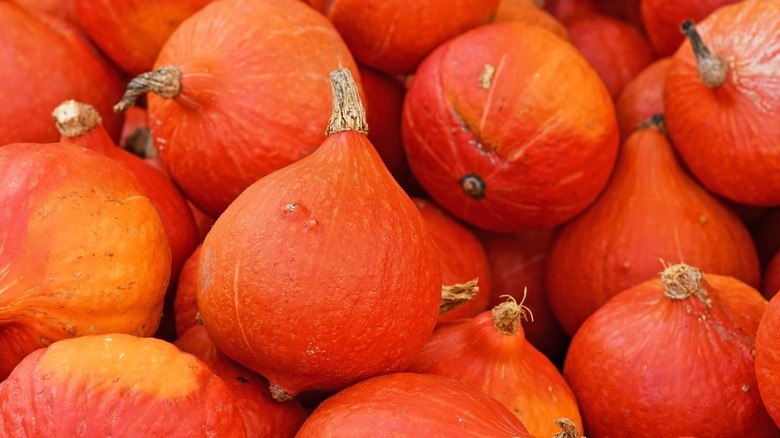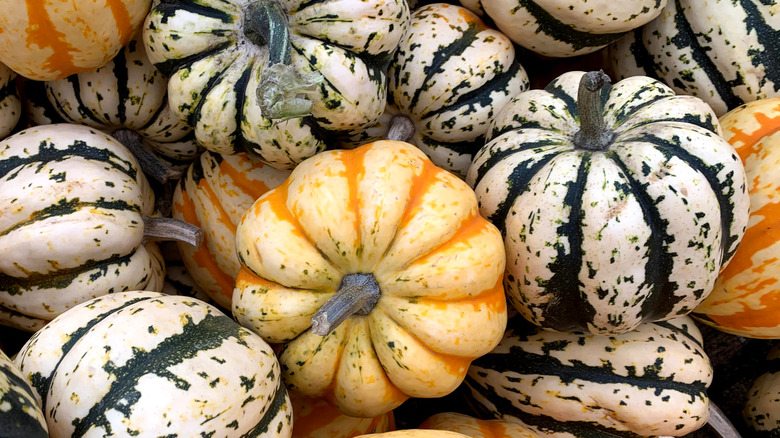25 Types Of Squash And When To Use Them
Squash is probably quite familiar, whether it's generously doled out on the Thanksgiving table or served cut, raw, and decadently drizzled with olive oil and pepper during summer. Despite the familiarity, the prevalance and relevance of squash, on the other hand, might be surprising. The National Museum of American History even goes so far to say that the history of this country can be told through its gourds! The history of squash even outlaps the national history of this United States. Food historians and horticulturists agree that squash has been a staple food of the Americas for some 8,000 years (via the University of Illinois). With so much history, it may be unsurprising to learn that are almost countless varieties of squash. They can be found in a variety of colors, tastes, and textures, so much so that it can be overwhelming to confront the tidal wave of variety.
To start simply, squash can be differentiated by whether the variety is a winter or summer squash. Winter squash tend to have thicker skin and a bold, rich flavor. The name winter squash is a bit of a misnomer, too. In fact, many are harvest-ready by autumn, but can be stored through winter. Summer squash are smaller and more watery. They should be consumed well before the squash's flesh hardens.
If your interest is piqued, you're in luck. Below are 25 varieties of squash that are sure to delight and excite.
Spaghetti squash
Bon Appétit theorizes that spaghetti squash earned its namesake from its pulp's habit of resembling spaghetti noodles once cooked. It's this similar appearance that might have made spaghetti squash a popular ingredient in many low-carb and gluten-free diets. But, even with the gimmicks and the alternatives attached to its name, spaghetti squash has a lot going on for itself. As the Cleveland Clinic notes, spaghetti squash is rich in vitamin C, vitamin B6, and is very fibrous. These are only a few of the benefits that come from this mellow squash, meaning there are certainly a lot of reasons to dig in.
But when digging in for some spaghetti squash noodles, be sure to have a good sauce or toppings mapped out! As Bon Appétit notes, much like the original spaghetti noodle, spaghetti squash doesn't do too well on its own. It tends to have a mild, if not outright bland taste when left undressed.
Spaghetti squash can be cooked a number of ways, but as noted by the Cleveland Clinic, it's a big gourd that needs a bit of attention and time to make sure it's been cooked thoroughly. Make sure to halve it before roasting or steaming! Spaghetti squash is a winter squash, but don't be deceived by the name: it can be found at farmer's markets come fall. Though available year-round at some grocers, spaghetti squash is usually at its freshest between September and October (via Live Eat Learn).
Crookneck squash
It takes only one glance to guess where crookneck squash gets its name. Also known simply as yellow squash, this classic Southwestern food is a summer squash, which means that it's best harvested and enjoyed before the plant reaches maturity and its skin hardens. Summer squash is best eaten while the skin is soft. This may seem counterintuitive, but as summer squash matures, its seeds tend to consume the plant's sugar. This in turn diminishes the fruit's flavor, as per The Spruce Eats.
In fact, according to The Spruce Eats, the skin is a big part of the crookneck's culinary appeal. The squash's yellow skin is bold and flavorful compared to the plant's mellow, watery, buttery, and slightly bitter flavor. This perfectly synchronized flavor makes the crookneck squash an overall knock-out. It's best eaten straight after harvesting, though of course after washing it off and perhaps removing some of its excess water.
That said, crookneck doesn't absolutely need to be eaten raw. Roasting also tends to bring out the best of this variety's flavor. LiveStrong also suggests sautéing crookneck or adding it into a stir-fry dish. Crookneck is, as per LiveStrong, chock-full of goodies like manganese and vitamins A, C, and B6. Because crookneck is so bulky without many calories, it makes a great addition into the daily diet of those looking to lose weight.
Straightneck squash
Straightneck squash is basically crookneck's straight-laced counterpart, all puns intended. Straightneck squash may be a familiar face or taste, so it's pretty hard to miss this lemon-yellow cylindrical squash. This squash might be so heavily incorporated into American cuisine because it was first cultivated here, and is even still predominantly grown here today (via Specialty Produce). Just as bright a yellow as its crookneck sister, the straightneck squash can be differentiated by, well, its straight neck. Like crookneck squash, straightneck squash is often also referred to as yellow squash. Though this variety is a summer squash, it can usually be found in grocery stores year-round.
This squash, like all summer squashes, is best enjoyed before its skin hardens. Speciality Produce recommends that straightneck squashes be harvested or purchased when they are around five to six inches in size. At this point, their skin will be slightly firm, but not hard, and the raw squash will have a somewhat nutty and peppery taste that, when cooked, transforms into a decadent buttery flavor. For those gardeners who are still a bit new to the game, Gardening Know-how suggests starting a garden patch with yellow straightneck. They are very forgiving and are well accustomed even to areas with a short growing season. Of course there's an added bonus to the labor of garden as, like most squash varieties, yellow squash's blossoms are sweet and edible.
Tromboncino
Tromboncino are swan-necked beauties whose very name evokes a symphony. For those who think of music when they hear the name, have no fear, there's no threat of synesthesia! As pointed out by the Plew's Garden Design, the name trombocino quite literally translates to little trumpet. First imported from the Americas to Italy in the 17th century, the trombocino, also known as trombetta, was welcomed with open arms. Maybe it's the country's proclivity towards opera, tromboncino's eye-catching shape, or its heavenly taste that simply demanded a musical name. However it's cut, the trombocino clearly has a name that fits.
Tromboncinos are, as noted by the Royal Horticultural Society, a cultivar of the butternut squash. Their taste is somewhat reminiscent of the better-known butternut squash, but maintains a uniquely sweet and mild taste. Though it might not be the boldest addition to the plate, there is a quiet beauty to the tromboncino. Unlike other squash, trombocino are ripe once their skin is only slightly soft and still a pale green. It's possible to harvest this squash in both winter and summer, though with minute differences. Winter tromboncino should be harvested once its skin hardens and turns a pale yellow. After enjoying a long bout of popularity in Italian and French markets, it's high time that this squash makes its way home.
Kabocha
Kabocha is another work of art, even inspiring some of Yayoi Kusama's larger-than-life works. Kabocha isn't only inspiring; it's also a supremely healthy addition to your diet. Verywell Fit confirmed that the green gourd is full of beta-carotene, vitamin C, and minerals like iron and magnesium. Kabocha has been potentially linked to a lower cancer risk and may help maintain eye health. It is chock-full of complex carbohydrates too, so it is very filling while nutrient-dense at the same time. Two birds, one stone.
Kabocha isn't only held near and dear because of its reported health benefits; it's also plainly tasty. Foodroots compares the taste of kobocha to butternut squash, if butternut were slightly sweeter. Its dry yet smooth texture really only adds to the entire kobocha taste landscape. In Japan, kobocha can be found transformed into many things, sweet and savory alike, including croquettes, pies, and simply roasted. Kabocha is a winter squash and can most often be found in late summer to early fall, though some specialty stores carry it year-round.
Carnival squash
Come one, come all! Carnival squash is a big-top delight. No one's sure how this squash got its name. Thankfully, the name remains the biggest mystery surrounding this squash. As per Specialty Produce, carnival squash is actually a newer hybrid that was first cultivated in the 1930s United States by crossing acorn and sweet dumpling squash. While the original intent from cultivator Ted Superak was to improve upon the taste of the sweet dumpling squash, it's a bit ironic then that carnival squash has made it to center stage for its looks. There's no shame in that though, and it's perfectly understandable how this happened in the age of social media!
Carnival squash has a delightfully mottled appearance, and when freshly harvested has a folksy mix of green and orange that makes it both at home as a Thanksgiving centerpiece and on Instagram. Over time, its color dilutes into a more laid-back mix of orange and cream.
Yet, those who aren't digging in are obviously missing the full picture. The Kitchn describes the carnival squash's flavor profile as both sweet and moist. This one-of-a-kind squash even has one more trick up its sleeve, with a unique maple syrup-like taste. The Kitchn suggests pairing this bold delight with a bit of butter and brown sugar before enjoying.
Acorn squash
One half of the carnival squash, the acorn squash's name most likely comes from its resemblance to the nut. But enough about the acorn squash in relation to others; it certainly has earned its own time in the spotlight. What gives the acorn squash its own punch, is the way it's able to straddle sweet and savory. WebMD describes the acorn squash as being just as at home with onions as it is in pies and even cookies. As noted by WebMD, acorn squashes are positively brimming with antioxidants and are great for those looking to incorporate more anti-inflammatory elements into their diet.
Acorn squash is a winter squash, with its skin hardening and turning a deep green color when ripe (via Gardening Know How). Typically, acorn squash is harvested by the first frost and can be found from late summer to early fall. Like most winter squashes, acorn squash can be stored for many months and will retain its flavor and nutrients for a long time.
For a winter squash, the acorn squash is relatively small. This lends itself well to easy cooking (via The Kitchn). The skin will even soften once cooked and becomes completely edible.
Chayote squash
Perhaps the most unique looking squash on this list, chayote squash almost resembles a pomelo. Its unique look is only the tip of the iceberg. Shape reports that it was first cultivated in Mesoamerica, where it remained prized for an incredibly long time. Chayote was even believed to have medicinal properties; its leaves were at one point used to treat ailments such as kidney stones. While this may now be outdated, the health benefits of the squash remain. WebMD notes that just one of these relatively small gourds contains as much as 40% of your daily recommended dose of vitamin B9. Chayote is also extremely rich in antioxidants and gives a healthy kick to any diet.
Chayote is a summer squash with extremely soft skin and a mellow yet sweet cucumber-like flavor, as per WebMD. Chayotes are very sugary and grilling them will naturally caramelize their soft flesh. Chayotes are really versatile and can be enjoyed in any which way. Shape mentions that the sweet and mellow chayote plays well with other, brighter, flavors native to Mesoamerica, like lime. Citrus and bold spices bring out the best in chayote. This squash has not yet found its footing in the more northern parts of the U.S., but might just be spotted in select groceries during summer.
Cinderella pumpkins
Now, there's a name! Cinderella pumpkins may just get their name from their striking similarity to the pumpkins depicted in the timeless Disney classic, as per The Spruce Eats. Likewise, Specialty Produce notes that there is speculation that this variety served as design inspiration for the orphan-turned-princess' magical carriage. Cinderella pumpkins can also be found under the name Rouge Vif d'Etampes.
Unlike other squashes on this list, this heirloom variety is actually an import from France (via Specialty Produce). Its French name, which translates to "vivid red," refers to this large gourd's most striking feature: its color. Indeed, these squashes look absolutely magical. They are also massive, to the point where it's not uncommon for them to weigh in at 20 pounds. Cinderella pumpkins have a high aesthetic value and have often been used for purely ornamental purposes, but there's a reason why this pumpkin was often used as vegetable stock in French soups.
This variety is a winter squash and tends to be found at the supermarket in mid-fall to winter. They are particularly creamy, as noted by Specialty Produce, and so do well in soups and chutneys. Cinderella pumpkins are mildly sweet and when roasted will caramelize naturally. While these pumpkins do have quite a few health benefits, like being rich in vitamins A and C, this tends to be undercut by baking the pumpkin into less healthy, though delicious, dishes like pie.
Pattypan squash
On the other side of the size spectrum is the neat and petite pattypan squash. Also known as sunburst squash, pattypan squashes are saucer-shaped, or more fittingly, sunburst-like summer delights. Though maybe it's yellow pattypans that seem the most sunny, green and white pattypans are just as delicious and just as likely to brighten up the plate. This summer squash is, according to Specialty Produce, miniscule and usually a mere 2 to 3 inches in diameter. They are more water than other summer squash varieties, to the point where they are about 90% water. Nonetheless, pattypan squash are rich in magnesium, iron, and vitamin A.
The Louis Bonduelle Foundation notes the small squash's versatility. It can be eaten raw and served in salads as squash strips. For a more indulgent meal, these tiny squashes can be stuffed with meats and cheeses, baked, and served warm. Pattypan squashes can be found in select grocery stores or farmer's markets throughout the summer. Their small stature allows cultivation in many spaces, even those that would usually be too small to support much gardening. Squashes in general have an easy-going nature and can be grown by gardening neophytes. Though, do be warned, as these little bursts of sun grow on thorny vines!
Zephyr squash
Zephyr squash is a two-toned summer varity that looks as if it's been dip-dyed. Zephyr is a multi-layered hybrid that was created by breeding crookneck with a delicata and acorn squash hybrid, as traced back by Specialty Produce. What resulted is, simply put, an example of mouthwatering produce.
Zephyr squashes are slightly firm once ripe and have a delightfully nutty-yet-sweet flavor that pairs nicely with other summer vegetables, as well citrus, herbs, and cheese (via Specialty Produce). This squash variety has a notably creamy texture, which adds a decadent layer to any dish it's been added to.
Harvest to Table goes one step further and notes that, unless the zephyr's skin is bitter, it need not be peeled. It also notes that if the squash is particularly watery, it makes sense to remove some water to help bring out the gentle squash's flavor. To drain zephyr squash, the website recommends sprinkling coarse salt over sliced strips of zephyr and letting it sit for 20 to 30 minutes. Zephyr squash is a particularly sensitive summer squash and is best approached with a "here for a good time, not a long time" mentality. Specialty Produce advises that the best way to preserve zephyr squash is by refrigeration, though it will only keep for around a week.
Calabaza squash
No, we're not talking Calabasas, California. Calabaza is a winter squash that can be as small as a cantaloupe or as large as a watermelon, according to Specialty Produce. Calabaza occupies a special place in Latin American cuisine, where it can often be found pre-sliced and pre-packaged. There's definitely reasons why this squash has established such a foothold in the Caribbean and Latin America. In fact, another name for calabaza is West Indian pumpkin. Sure, this larger squash has many of the important nutrients that define winter squashes like vitamins A and C, but it might be the large gourd's culinary prowess that really puts it on the map.
Calabaza is extremely creamy and comparably sweet to butternut squash. Its mild flavor, which is sweet yet slightly nutty, lends itself very well to both sweet and savory baking. This pumpkin can be found in pale oranges and deep dusty greens rinds. If purchasing pre-packaged calabaza slices, follow Allrecipes' advice and look to make sure that its unmistakably bright orange flesh is firm without being dry and is also uniformly colored. Calabazas are extremely filling, so it makes sense that it's often used as a filling, in anything from empanadas to unique twists on pumpkin pie.
Papaya squash
Papaya squashes are easily the youngest squash on this list, being first cultivated in 2001. They have quickly grown to prominence and even won the All-Americans Selections of 2003 (via Specialty Produce). The papaya squash's name comes from the its resemblance to papaya, with bright yellow skin, a slight bottleneck shape, and green and white freckles. The papaya squash is also sometimes referred to as the papaya pear squash, which may be reference the squash's pear-like shape, as per Specialty Produce. But, this squash still has a flavor all its own. Papaya squash has an exceptionally delicate flavor that is mildly sweet and exceptionally watery. It's a team player that does well in a summer ratatouille or paired with some nice herbs and cheese.
Like most summer squashes, papaya squashes will begin fruiting near early summer and keep doing so throughout the warm months. Papaya squashes can be easy to grow, though it may be tougher to find them in stores. However, with such a delicate taste, it can be easy to overcook and overpower them.Our Everyday Life suggests that the real trick isn't how papaya squash is cooked, but rather whether or not you keep an eye on the time, making sure that these fragile yummies don't cook for longer than need be.
Banana squash
Despite its tropical name, the banana squash is actually a winter squash. But it's not really the seasonality that earned this crop its name (via The Spruce Eats). Banana squash is most commonly found with creamy white skin and oblong proportions, which really does bear resemblance to the beloved yellow banana supermarket staple. A major difference between the two is the squash's massive size. It's not uncommon to find banana squash coming in at about two to three feet long and even weighing up to 35 pounds. Now that's a big banana!
As such, most American grocery stores won't commit to the space that a banana squash demands. They are, as observed by The Spruce Eats, most commonly found gutted and served in less intimidating pre-packaged sections at the grocery year-round, though they are at their freshest from autumn to winter.
The banana squash is particularly fibrous, carries a good amount of vitamins A and C, and presents a medley of iron and calcium (via Specialty Produce). When cooked, the orange flesh of the banana squash dries slightly and takes on a rich scent and earthy yet sweet flavor. The Spruce Eats suggests either pairing a roasted banana squash with pork and apricots or using it as a topping on an autumnal pizza. For dog owners looking to give their pooch a nutrient boost, steamed or roasted banana squash can be a good source of much-needed vitamins and nutrients as well (via Can Dogs Eat It).
Ambercup squash
A relative of the buttercup squash, the ambercup squash may look like a pumpkin, but the taste is unmistakably squash. In fact, some, like Davison Orchards of California, compare ambercup's taste to butternut squash. That said, ambercup comes in a much smaller package that's a bit more manageable to not only cut and roast, but to store. This squash is a winter variety and is harvest-ready by early to mid-fall.
According to Davison Orchards, ambercups can be stored for up to six months without spoiling. That affords plenty of opportunities to indulge in this tiny delight. This squash is dry in texture, and so the orchard doesn't suggest doing more than drizzling pieces of it with a bit of olive oil, sprinkling on some salt, and then roasting them to enjoy this variety.
But that isn't to say that this orange beauty can't be a bit more dressed up! Insight Flavor even sought out ambercup specifically to make a cold weather-ready mac and cheese. Although the squash's texture is dry, it's also smooth. This adds a unique creaminess and complex notes to the ever-classic comfort food. The squash's bright orange flesh even adds a certain new bonus element of orange to a classic go-to.
Jarrahdale
Sacre bleu! Jarrahdales are blue and bold, but once cut open they reveal a bright orange interior. Jarrahdale is actually a hybrid of Cinderella and blue hubbard squashes, and combines many of the two's best traits (via Minnetonka Orchards). For those now familiar with the Cinderella, the Jarrahdale might just be a recognizable face, albeit this time in blue. Jarrahdales also have a similar shape to the Cinderella pumpkin, which is referred to by some as a cheese pumpkin, due to the fact it almost resembles a wheel of cheese. Indeed, Jarrahdales are gorgeous winter squashes and can make for absolutely stunning fall decor, and maybe even function as an avant-garde Jack-o'-lantern.
But don't underestimate the Jarrahdale just because it's pretty! This pumpkin looks good enough to eat, and indeed it is. When it comes to flavor, the Jarrahdale is close to the hubbard, with a sweet flavor. Home for Harvest describes the Jarrahdale pumpkin as a true "gourmet" pumpkin. Its taste is rich and its flesh dry. More often than not, Jarrahdale purée makes it way into baked goods like rich winter and autumn pies, scones, and muffins. This isn't to say it doesn't make for a comforting bowl of soup or might even make its way into other, more adventurous dishes. While these unique squashes are currently more popular in their homeland of Australia, with their stunning color and potential in the kitchen, perhaps they'll catch on in the States.
Hubbard
The other half of Jarrahdale, hubbard squash is a gentle giant in the winter squash world. After all, it's not out of the ordinary for these pumpkins to clock in at around 15 pounds, sometimes even tipping the scales at a whopping 50 pounds! Similar to its offspring, hubbard squash is also a stunning slate gray to light blue in color whose taste has been described as somewhere between sweet potato and pumpkin (via Allrecipes). Unlike the Jarrahdale, the hubbard squash does come in a variety of color, from dark green to pale blue, and very often with bumpy skin, as per the Food Network.
Hubbard is definitively a winter squash, and so will not be found in the stores any earlier than mid-autumn, as noted by Allrecipes. Thankfully like most winter squashes, preserving hubbard squashes is not a complicated affair, and they can be stored for up to five months without any fuss. Like a fine wine, hubbard's flavor only gets better with age (via The Spruce Eats).
The Spruce Eats does note that the hubbard's texture might make things complicated, as its soft and sweet taste is unfortunately met by grainy flesh. But don't let that dissuade you, as there's a lot of good to work with here. For one, letting the squash age will help with those textural issues. Also, baking or cooking hubbard can work to even out the less than ideal mouthfeel.
Costata romanesco
The Maryland Grows chapter of the University of Maryland holds that the costata romanesco squash is the squash for those who don't like squash. The argument it makes for this classic zucchini is both comprehensive and convincing. For one, this variety is beautifully green with slight white mottling and bold stripes that give it a zebra-like appearance. It has a meaty yet dry texture that allows it to cook really well or be shredded to use in baked goods or as a fritter. Furthermore, its flavor is complex, coming across as sweet, yet nutty and earthy.
Costata romanesco, also known simply as costata or ribbed Roman, an Italian heirloom variety. It's definitively a summer squash, though it fruits earlier than other types and can even be found ready-to-eat in spring as well as summer, according to Specialty Produce. While the costata has a classic summer squash taste, what makes it unique is that it retains flavor even as it grows. Whether small or big, the ribbed Roman will pack a flavorful punch.
As Specialty Produce notes, this heirloom Italian variety is most popular in Italy, while the United States still prefers other commercial varieties. Those with keen eyes at the farmer's market or grocery store are definitely advised to go and investigate what the fuss is all about, as this squash will surely not disappoint.
Delicata squash
Sometimes a spade is a spade, especially since delicata squashes earned their name from their delicate skin, which tends to bruise and cut easily for a winter squash (via Specialty Produce). But, don't be fooled. While this squash might most commonly be found under the name delicata, it is also commonly referred to as peanut squash or sweet potato squash. The latter two names might give a good clue to the winter squash's flavor, which is both sweet and rich. The squash's bold flavor might come as unexpected given the fruit's notably fragile exterior. The delicata's skin is just as unexpectedly bold, sporting a pale and creamy yellow that is often striped with deep green or orange. Although delicata is a winter squash, it is typically only available from early fall until early winter, according to Specialty Produce.
Delicata are rich in a medley of nutrients and vitamins such as vitamins A and C, potassium, and beta-carotene. The squash is about mid-range when it comes to carbohydrates, and LiveStrong notes that the delicata is especially well-suited for the keto diet. It comes as no surprise that, given the delicata's thin skin, that it does not store as well in comparison to other winter squashes (via Soil Born Farms). Those cooks with thick skin, however, will make do and find freezer space for their frozen and cubed delicate delicatas.
Eight-ball squash
Eight-ball squash is another variety whose name gives away its most unique trait. In this case, the eight-ball squash is almost perfectly round. Eight-ball squashes are a hybrid summer squash variety, with a dark green exterior graced with light white freckles and green stripes. Once cut, they reveal a creamy and shockingly lily-white interior (via Specialty Produce). Despite their completely polar opposite shapes, eight-ball squash tastes very similarly to costata romanesco squash, with a buttery and deep taste.
Unlike the costata romanesco, the eight-ball squash's flavor does change as the fruit grows. Specialty Produce finds that the real sweet spot for eight-ball squash tends to be when it's no more than 4 inches in diameter as the fruit has the tendency to take on a stiffer, more woody taste as the fruit grows. The eight-ball's unique shape lends itself to bold stuffed squash recipes, and the squash can be halved or hollowed and filled with all sorts of fixings. As noted by Specialty Produce, although eight-ball squash is available year-round, it is in season throughout the summer.
Sugar pumpkins
Sugar pumpkins, also called pie pumpkins, are as the name might suggest, squashes that are destined for greatness in all matters concerning desserts (via Bon Appétit). Sugar pumpkins are the petite counterparts to the larger orange pumpkin. They're also much less fibrous, which makes them well-suited for all sorts of kitchen magic.
Sugar pumpkins are really perfect for autumn cooking given that, similar to acorn squashes, they flirt with both sweet and savory applications. As described by Bon Appétit, this variety is solid but turns creamy when cooked up, so a puréed sugar pie soup might just be the move here for a classic fall treat. The possibilities are truly endless, however, so don't let tradition limit you. Maybe a good place to start is with the obvious: a sugar pie pumpkin pie.
Sugar pumpkins are exceptionally rich in vitamin A, though once mixed with actual sugar, baked, and topped with all sorts of goodies, the health aspects do decline somewhat. The Spruce Eats notes that sugar pumpkins keep well, storing up to 6 months in the freezer or even 9 months as they are, as long as the pumpkins are kept out of the sunlight.
Butternut squash
Now, this is a squash that needs no introduction, as many already know of butternut squash. According to WebMD, butternut squash's popularity is nothing new and it's long been in the American diet. That being said, it didn't reach the United States' consumer market until around 1944, where it then quickly gained traction. It can now be found outside the States as well, particularly in New Zealand and Australia (via Persistence Market Research).
It may come as a surprise that beyond the butternut squash's characteristic nutty and sweet flavor, the squash is exceptionally nutritious. The same research study notes that the squash is fibrous and contains many important minerals like manganese, magnesium, and potassium. Butternut squash is also a veritable cornucopia of vitamins A, C, and E. In regard to vitamin A in particular, WebMD observes that one cup of cooked butternut squash contains a whopping 457% daily recommended intake of vitamin A. That's certainly a good reason to turn towards a classic! Thankfully, there are quite a few butternut squash recipes to help you take full advantage of this squash variety.
Buttercup squash
Buttercup squash is also known as turban squash, most likely due to its appearance (via The Spruce Eats). This two-tiered squash is nothing if not bold. It is a multi-colored mix of orange, white, and green with stripes and spots, along with plenty of bumps. It's also mid-range in size, usually weighing under six pounds. A winter squash, buttercup squash is at its peak between fall and winter. It has a hard skin that only gets firmer as it ripens, and can be stored in a dry spot for a month or so.
The Spruce Eats notes that the buttercup squash often gets a bad rep when it comes to culinary pursuits. It has been criticized for being watery, and of course its unique shape makes cutting and peeling notoriously hard. The Spruce Eats suggests that, after hollowing the pumpkin, you can steam it in order to make peeling easier, if only by a bit.
As far as texture goes, there's a reason why buttercup has remained a mainstay in its homeland of the Caribbean. Buttercup is a sweet treat that makes a creamy ingredient for fall cooking. It certainly is a bonus that it's filled with all the nutrients and vitamins that characterize winter squash (via Taste of Home). When looking for a perfectly ripe buttercup, check the top of the squash. If it's still firm, the buttercup is still ripe for the taking, literally.
Red kuri squash
Also known as Hokkaido pumpkin, the Japanese red kuri is exceptional in many ways. For one, its bright red and orange color is reminiscent of a flame in the otherwise somewhat dull palate of fall and winter produce. Despite its onion-esque shape, the Hokkaido pumpkin is naturally sweet and, as The Spruce Eats notes, its sweetness is only enhanced when it's roasted.
Unlike some other winter squashes, the skin of the red kuri squash is edible. As noted by The Spruce Eats, even when it's cooked and softened, the red kuri's flesh remains slightly tough and chewy in texture. Its somewhat sugary flavor lends itself well to both sweet and savory dishes, from dessert to soup.
A winter squash, red kuri is of the more sensitive kind and doesn't typically make it past the first frost (via Nature and Garden). It's at its peak for harvesting in October, though these beauties can be stored exceptionally well for a few months and will retain all of their bold flavor during that time. The bright red of this squash is a good indicator that it's rich in vitamin A, but, as Nature and Garden points out, vitamins B, C, D, and E are all along for the ride too. Now that's a pretty sweet deal.
Sweet dumpling
The sweet dumpling squash has done much to earn its name. It's actually a form of the previously mentioned delicata, the biggest differentiation between the two being shape. Sweet dumpling squashes are round, tiny things, as one could guess from the moniker. They have deep ridges and their stems lie low. They are often found in yellow or orange, are mottled, and have deep and dark stripes (via The Spruce Eats). All told, there's a lot going on in this tiny package.
Like delicata, sweet dumplings are winter squash. Sweet dumplings get better with age and tend to get even sweeter as they mature. Its slightly sugary, yet nutty flavor makes for rich purées, while its dry flesh caramelizes well when subjected to heat. Talk about preforming well under pressure!
With its unique skin, baked sweet dumpling squash makes for a fetching, not to mention quick, dish. Of course, the squash's round shape lends itself well to hollowing it out and stuffing. Like most winter squashes, sweet dumplings have a good shelf life.
